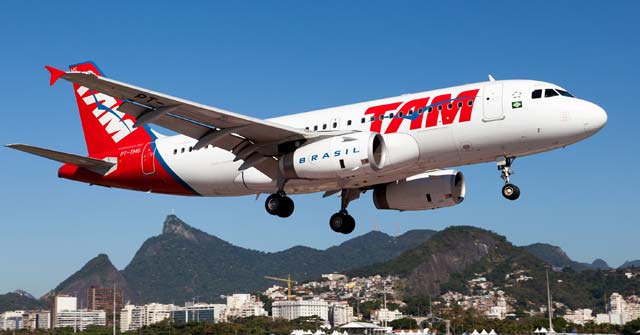Pilots of a TAM Airbus A319 did not cope effectively with unreliable airspeed indications after the aircraft collided with a plastic banner being towed by a hot air balloon, blocking four air data sensors.
The aircraft struck the banner at 12,000ft after taking off from Rio de Janeiro on 17 June 2011, as it flew the standard PORTO 6 departure from Santos Dumont airport.
Its crew had been advised of the presence of hot air balloons in the terminal airspace. But Brazilian investigation authority CENIPA says the crew’s attention was “diverted” because the captain was demonstrating a flight-management system function to the first officer.
After a “late” sighting of the balloon, it adds, both pilots simultaneously attempted an evasive manoeuvre using their sidesticks, causing a dual-input warning.
The manoeuvre was insufficient to prevent the aircraft’s striking the balloon’s banner, tearing off shreds which blocked three of the jet’s pitot tubes as well as a total air temperature sensor.
With the loss of the air data information, the autopilot and autothrust became inoperative. The aircraft switched to alternate flight law – losing automatic angle-of-attack protection and other functions – and presented several messages to the pilots regarding the degraded capabilities.

AirTeamImages
CENIPA indicates a breakdown in task sharing and a lack of co-ordination followed, with the captain initially telling the first officer to disregard an important message indicating an airspeed discrepancy but then ordering unreliable-speed procedures from the quick-reference handbook.
Various procedures from the handbook were not carried out, including notifying air traffic control of the situation. When the captain sought pitch and thrust reference data, the first officer erroneously used tables corresponding to aircraft weights above 66t when the twinjet was around 54t.
The aircraft (PT-MZC) also proceeded to climb to 31,000ft in reduced vertical separation minima airspace despite being outside the criteria to operate at such flight levels. Altitude variations “throughout the flight” triggered alerts, says CENIPA.
Despite the aircraft’s inability to meet navigation requirements for the approach into Belo Horizonte the crew continued without informing air traffic control of the problem, and performed the approach by referring to airspeed indicators whose reliability had not been verified.
CENIPA says it has not determined whether “ignorance or forgetfulness” led the crew to proceed with the flight in RVSM airspace and the subsequent landing. Between them the pilots had over 5,700h on type but investigators determined that they had not been fully trained for unreliable airspeed scenarios.
None of the 101 occupants was injured during the incident, but residue from the balloon banner was still contaminating the A319’s air data sensors.
CENIPA warns that a collision with the balloon envelope could have been “catastrophic”, given the forces involved. It points out that there were 143 balloon sightings by pilots last year and that some evasive manoeuvres were of such severity that they triggered cockpit alarms.
Source: FlightGlobal.com























